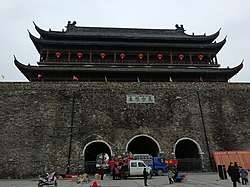Fengyang County
Fengyang County (simplified Chinese: 凤阳县; traditional Chinese: 鳳陽縣; pinyin: Fèngyáng Xiàn) is a county in north-central Anhui Province, China. It is under the administration of Chuzhou, a prefecture-level city. The county was home to 765,600 people as of 2013.[1]
Fengyang 凤阳县 | |
|---|---|
County | |
 | |
| Coordinates (Fengyang County government): 32°52′33″N 117°31′54″E | |
| Country | People's Republic of China |
| Province | Anhui |
| Prefecture-level city | Chuzhou |
| Area | |
| • Total | 1,949.5 km2 (752.7 sq mi) |
| Population (2013) | |
| • Total | 765,600 |
| Time zone | UTC+8 (China Standard) |
| Postal code | 233100 |
Administrative divisions
Fengyang County is divided into fourteen towns and one township.[1] The county seat is in Fucheng Town.[1]
Towns
The county is home to the following fourteen towns:[1]
- Banqiao (板桥镇)
- Damiao (大庙镇)
- Fucheng (府城镇)
- Guantang (官塘镇)
- Hongxin (红心镇)
- Liufu (刘府镇)
- Wudian (武店镇)
- Xiquan (西泉镇)
- Linhuaiguan (临淮关镇)
- Zaoxiang (枣巷镇)
- Yinjian (殷涧镇)
- Zongpu (总铺镇)
- Xiaoxihe (小溪河镇)
- Daxihe (大溪河镇)
Huangwan Township
The county's sole township is Huangwan Township (黄湾乡).[1]
Geography
The county's northern border is formed by the Huai River and neighboring Wuhe County.[1] The county is also home to the Huayuan Lake, which totals about 30 square kilometers in size.[1]
Climate
The average annual temperature for Fengyang County is 14.9 °C, and the average annual precipitation is 904.4 mm.[1]
History
Pre-Ming Dynasty
During the Xia, Shang and early Zhou dynasties, the Dongyi peoples inhabited this area and were collectively known as the Huaiyi after the Huai River. During the late Western Zhou Period and the early Spring and Autumn period, the Dongyi became increasingly sinicized and formed their own states. During the late Spring and Autumn period, the once-powerful Dongyi state of Xu was pressured from all directions and destroyed through a series of wars with its neighbors, such as the Chu State and the Wu State. Another Dongyi State was the small Zhongli State, which was a part of the Huaiyi Confederation led by the State of Xu. Tombs belonging to the royalty of the Zhongli State were discovered in excavations between 2005 and 2008 near Fengyang. Eventually, the Huaiyi peoples were either pushed south or assimilated.
Ming Dynasty
Fengyang's best known historical site is linked with the name of the county's most famous native, Zhu Yuanzhang (1328-1398). Although coming from a poor family, he became an important rebel leader and, later, the founder of China's Ming Dynasty. Once entrenched as the Hongwu Emperor in the nearby Nanjing, he honored the memory of his father, Zhu Wusi (d. 1344), and his mother, Lady Chen, by posthumously raising them to imperial dignity, and building for them an imperial-style mausoleum, known as Ming Huangling (明皇陵, literally, "Ming Imperial Mausoleum").[2] The emperor even started building the new imperial capital, named Zhongdu (中都; 'The Central Capital') near his childhood hometown, but the project was eventually abandoned.[2] The stone figures of the Huangling Mausoleum have survived, and have been re-erected at the original location, some 7 km (4.3 mi)south of the county seat ((32°48′50″N 117°31′10″E)).[3] The mausoleum statuary and the remains of the capital-building project are protected as a national historic site known as "Zhongdu Imperial City of the Ming and the Imperial Mausoleum's Statuary" (明中都皇故城及皇陵石刻).[4] In 1370, existing counties in the area were merged into a new county, named Linhuai County.[5]
Qing Dynasty
In 1754, Linhuai County was restructured into a new county called Fengyang County, which serves as the descendant of the modern Fengyang County.[5]
Recent History
The county's borders are jurisdiction has changed numerous times since its Qing-era formation.[5] In 1974, future Chinese Premier Li Keqiang was sent to Damiao, Fengyang County as part of Mao Zedong's Down to the Countryside Program.[6][7][8] Here, he did manual labour throughout the day and studied for university, Li recounts his days in the county as "hard times".[6] He rose up to the rank of Damiao's Communist Party branch secretary in 1976, before leaving for Peking University in 1978.[8]
Economy
Fengyang County's natural resources include limestone, quartz, marble, vermiculite, and asbestos.[1]
Transportation
Key highways in the county include the G36 Expressway, Anhui Provincial Highway 101, Anhui Provincial Highway 207, Anhui Provincial Highway 307, and Anhui Provincial Highway 310.[1] The Beijing-Shanghai High Speed Rail also passes through the county.[1]
See also
- Fengyang Flower Drum, a famous folk song genre from Fengyang County
- Xiaogang, Anhui, a village in Xiaoxihe town
References
- 凤阳县概况地图_行政区划网(区划地名网) www.xzqh.org (in Chinese). XZQH.org. Retrieved 2020-04-28.
- Eric N. Danielson, "The Ming Ancestor Tomb Archived 2013-09-27 at the Wayback Machine". China Heritage Quarterly, No. 16, December 2008.
- Huangling Mausoleum of the Ming Dynasty Archived 2010-04-13 at the Wayback Machine
- Zhongdu Imperial City of Ming and Stone Tablets in Imperial Mausoleum Archived 2011-10-02 at the Wayback Machine
- 凤阳县历史沿革_行政区划网(区划地名网) www.xzqh.org (in Chinese). XZQH.org. Retrieved 2020-04-28.
- hweepeng@st (2016-05-15). "President Xi Jinping and other sent-down youths who are now big names in China". The Straits Times. Retrieved 2020-04-28.
- "Li Keqiang 李克强" (PDF). Brookings Institute. March 18, 2018. Retrieved April 28, 2020.
- "Li Keqiang -- Premier of China's State Council - Xinhua | English.news.cn". www.xinhuanet.com. Retrieved 2020-04-28.